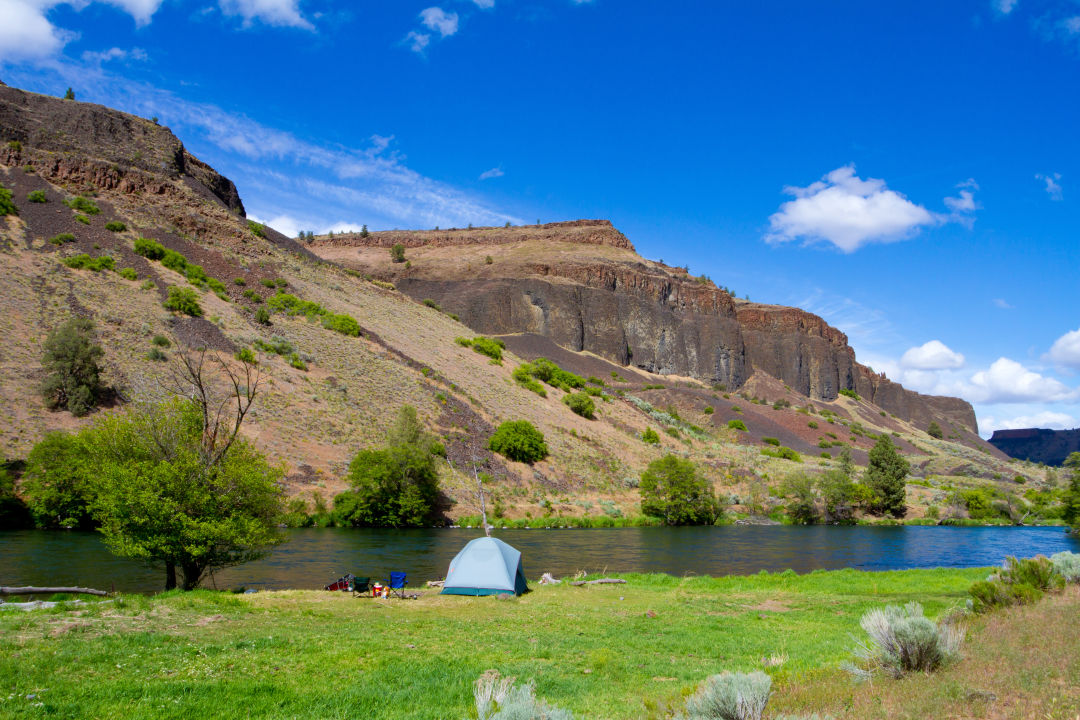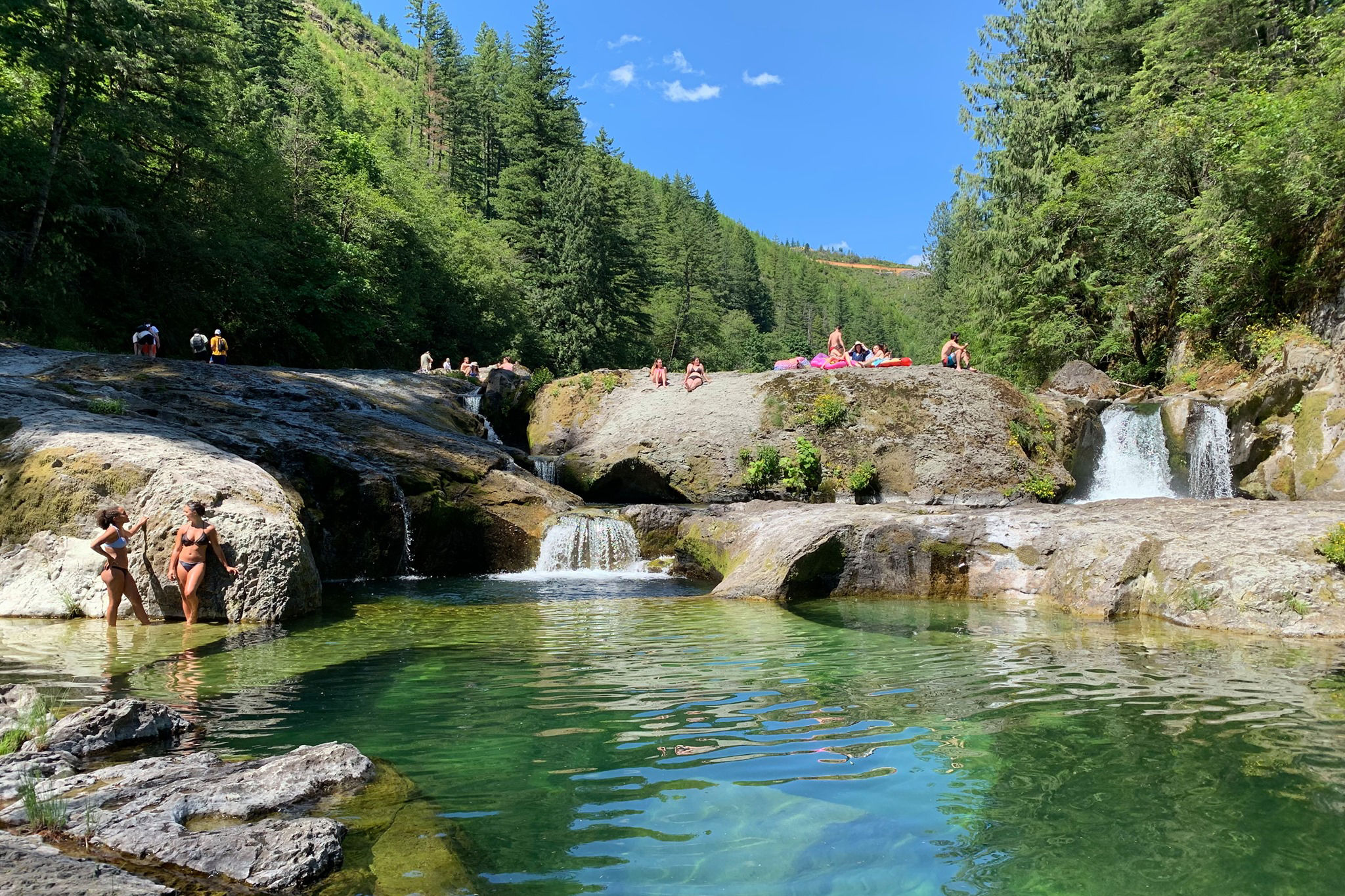What's the Hold-Up with Oregon's New Office of Outdoor Recreation?

Rustic camping on the Deschutes River. Oregon's parks and natural areas face record demand. The state's new Office of Outdoor Recreation hopes to offer big-picture solutions—once it gets off the ground.
In 2013, Utah started the trend. Colorado, Montana, North Carolina, and Washington followed. Last August, Oregon jumped onboard, as Governor Kate Brown signed HB 3350 to create Oregon’s first-ever Office of Outdoor Recreation. But it’s been a slow start for the novel agency. Nearly 10 months later, the supervisory Oregon Parks and Recreation has yet to find a director to head the one-person “office.”
So what’s the hold-up? And what can Oregonians expect once the office is formally launched? We called Chris Havel, the parks agency’s associate director, to find out.
1. Sure, being director of the Oregon Office of Outdoor Recreation sounds like somebody’s dream job. Turns out it’s also a big ask.
“We knew at the beginning it was going to be hard to find the right person,” Havel tells Portland Monthly. “We committed to our partners to make a good, careful hire even if it meant it took a little longer than we expected.”
Back in November, fewer than 100 people applied for the $69,240–$97,092 salaried position during the nationwide open call. In the end, none were quite the right fit for a position that, as envisioned, is pretty complicated.
Havel says that the ideal candidate needs to understand Oregon’s diversity—both in landscape and demographics—to forge unions between conflicting interests. In particular, the agency seeks a person who can understand and empathize with wide-ranging perspectives: from outdoor enthusiasts and environmental nonprofits to business owners and government agencies. Havel says they saw pieces of these components in last fall’s applicants, but none who brought the full package.
So this past winter, the search went grassroots, tapping directly into the social network that helped support last summer’s bill: primarily, partners from Oregon’s outdoor recreation industry. This network, Havel says, “isn’t that large, and quality people tend to float to the top pretty quickly.”
As a result, the agency has a few promising interviews scheduled for this May; the new candidates, Havel says, bring the entire package to the table. “I’m cautiously optimistic,” he says.
2. OK, so maybe we’ll have an official state director of outdoor recreation this summer. But what will the office actually do?
Within the first few months, Havel expects the new hire will form an advisory committee (or “think tank”) tasked with finding policy-based solutions—e.g., negotiating outdoor recreation-related laws and budgets, and establishing baseline metrics for its economic and employment impacts.
Generating reports will be a big component of the new director’s work, Havel says—the groundwork for later proposals the office will submit to federal, state, and local decision makers. Among the questions to address:
- Does every community have adequate infrastructure to navigate public and private lands and waters?
- Does everyone feel welcome in Oregon’s outdoor spaces, and is there sufficient public access?
- How can Oregon’s natural resources best be protected?
- How can progress be maintained with ongoing social and financial support?
If this work feels behind-the-scenes, Havel agrees. Rather than focus on individual projects—a swimming pool here, a trail there—the idea is to create an entity that can mediate between agencies, organizations, and more than 200 recreational groups that have historically had difficulty seeing eye-to-eye.
The office aims to operate without bias, Havel says. “It’s not about, ‘More people hike than hunt, so we’re going to pay more attention to hikers.’ Our geography is as diverse as our people, and with a good, high-level view, we should be able to accommodate everybody’s needs.”
3. Sounds good in theory, but let’s look at who floated this idea in the first place…
We spoke with some of the private partners who publicly support the initiative—among them, the Mazamas mountaineering club, the Northwest Outward Bound School, Uncage the Soul (an outdoor video production company), and Hydroflask—to ask why they wanted the bill in the first place.
John Waller, founder of Uncage the Soul, says he hopes the office's advocacy will help spread tourists across the state—rather than having them jostle elbow-to-elbow at, say, Multnomah Falls, wearing down infrastructure and nature.
Others more directly connected the endeavor with dollars, citing an impressive statistic from the Outdoor Industry Association: that Oregon’s outdoor recreation generates $16.4 billion in consumer spending annually. Sixty-seven percent of Oregonians are already sold on outdoor recreation; getting even more outdoors would certainly be a boon to to many businesses: from outfitters to apparel makers, gear manufacturers to hospitality providers.
“We need people participating regularly in outdoor recreation so they’ll use more Hydroflask products,” explains Mike Wallenfels, Hydroflask’s Global VP of Sales. “But on a business side, the state [can] deliver workforce. We’d like to make sure that outdoor business and outdoor recreation becomes part of the core curriculum within any of the state-operated universities.”
4. We’re not the first state to try this. So what can we learn from Washington and Utah?
Oregon’s new office sounds mighty ambitious; Utah and Washington have been here before. These state offices are excited to collaborate with Oregon. Their directors also urge Oregon's future hire to play the long game.
“The first year, almost exclusively, will be spent in a car eating fast food, traveling around letting people know who you are and what you’re there to do,” says Tom Adams, director of Utah’s Office of Outdoor Recreation.
Utah—the first state to create an office of outdoor recreation in 2013—has succeeded in subsidizing dozens of infrastructure projects through a grant program started in 2015. It started with countless conversations. Adams encourages Oregon’s hire to connect with every community to discuss how they—and not just the I-5 corridor—will benefit.
In Washington, John Snyder has held Adams’s equivalent position since 2015. As a policy advisor, he reports directly to Washington Governor Jay Inslee. Snyder refers to himself as the glue working behind the scenes; his work includes everything from advocating for bills to expanding existing grant programs like the state's “No Child Left Inside” program, which teaches teach K-12 students outdoor recreation and education.
Snyder cautions Oregon’s future hire to think broadly about the benefits of outdoor recreation: jobs, revenue, environment, and public health. Advises Snyder: “Whenever you can, connect outdoor recreation to some other bigger benefit it’s easier to promote and advocate.”
-
And who is paying for all this?
HB 3350 allocated a one-time, fixed amount—drawn from state income and property tax—to create the office in Oregon. But its future funding stream is uncertain, as Oregon Parks and Recreation doesn’t fund any other program with taxpayer money. (Its budget is funded by the Oregon Lottery, park visitors, recreational vehicle registration, and other fees.) So, while Havel assures Portland Monthly the director position is secure for the long-term, we'd guess one of the office’s priority tasks will be securing its own paycheck. Because without a roof over its head it'll be, um, well, outdoors.




